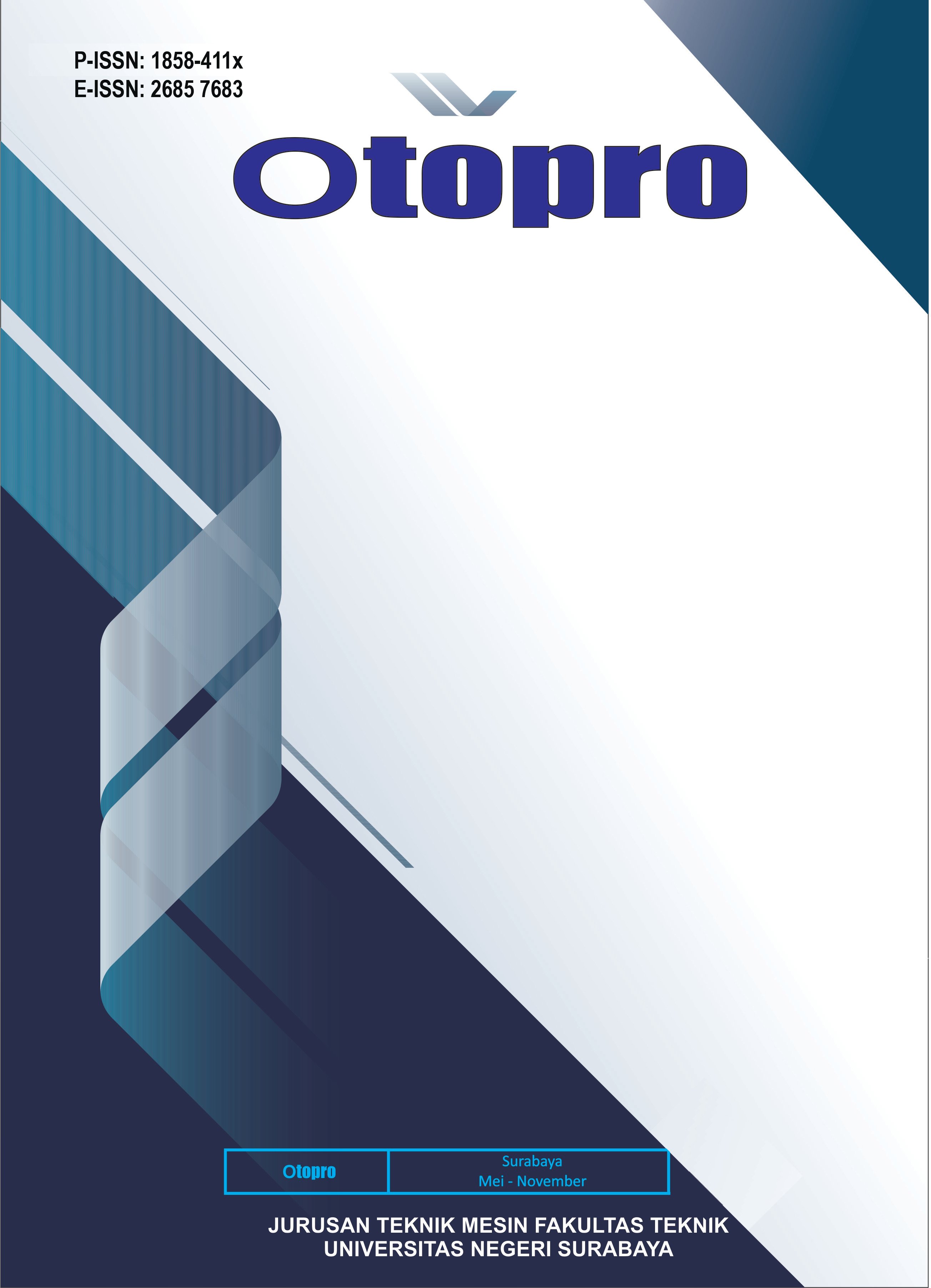PENGARUH JUMLAH BILAH PENGARAH ANGIN JENIS OMNIDIRECTIONAL TERHADAP KINERJA MODEL TURBIN ANGIN SAVONIUS
DOI:
https://doi.org/10.26740/otopro.v18n2.p65-70Keywords:
ODGV, Guide Vane, savonius wind turbine model, wind tunnel , torqueAbstract
Recently, many countries are looking for alternative energy sources that are renewable and environmentally friendly, one of which is wind energy, with Indonesia's wind energy potential of 9 GW and relatively low wind speeds and geographical position, it is necessary to develop wind turbine technology that is suitable for wind characters in Indonesia. In this research, an omnidirectional wind director model (ODGV) is developed around the savonius wind turbine which aims to improve the performance of the savonius wind turbine model. The ODGV consists of several blades that function to direct the wind at 45o counterclockwise, with the aim of accelerating the flow so as to increase the positive torque of the concave side blades and reduce the negative torque of the convex side blades of the savonius wind turbine model. An open-type wind tunnel was used to test the savonius wind turbine model with ODGVs. Five ODGVs were developed in this study, using 4, 6, 8, 12, and 16 directional blades with a width of 5cm. The data were analyzed using descriptive analysis. The results show that the ODGV can substantially improve the rotor performance, depending on the number of directional blades. The ODGV with 12 directional blades produced the greatest effect on the performance of the savonius wind turbine model at Re = 93269 which could increase the Cp 69.15% more than the savonius wind turbine model without ODGV. As the Reynolds number increases, the ODGV tends to significantly improve the performance of the savonius wind turbine model.
References
The IPCC Special Report on Renewable Energy Sources and Climate Change Mitigation (online) (http://www.economicpolicyresearch.org/images/docs/SCEPA_blog/economics_of_climate_change/Edenhofer_Presentation_Sept_2011_Compatibility_Mode.pdf accessed on 9 September 2019).
Danish Energy Agency, 2017, Powering Indonesia by Wind (online), (http://www.ea-energianalyse.dk/reports/1650_powering_indonesia_by_wind.pdf, accessed on 9 September 2019).
Siregar, I. H., and Ansori, A., 2016. Performance of Combined Vertical Axis Wind Turbine blade between airfoil NACA 0018 with Curve Blade with and without Guide vane. International Journal of Scientific & Engineering Research, 7 (8), 863-867
Roy, S., & Saha, U. K., 2013. Review of experimental investigations into the design, performance, and optimization of the Savonius rotor. Proceedings of the Institution of Mechanical Engineers, Part A: Journal of Power and Energy, 227(4), 528-542
Mahmoud, N. H., et al., 2012. An experimental study on improvement of Savonius rotor performance. Alexandria Engineering Journal, Vol. 51, No. 1, pp. 19-25.
Ali, M. H., 2013. Experimental comparison study for Savonius wind turbine of two & three blades at low wind speed. International Journal of Modern Engineering Research (IJMER), 3(5), 2978-2986.
Wenehenubun, F., Saputra, A., & Sutanto, H., 2015. An experimental study on the performance of Savonius wind turbines related with the number of blades. Energy Procedia, 68, 297-304.
Fitranda, Robby Ilham., Siregar, Indra Herlamba., 2014, Karakteristik Turbin Angin Savonius 2 dan 3 Blade dengan Menggunakan Bantuan Guide Vane, Jurnal Teknik Mesin Vol 2, No 02. 125-131.
Modi, V. J., & Fernando, M. S. U. K., 1989. On the performance of the Savonius wind turbine. Journal of solar energy engineering, 111(1), 71-81.
Kacprzak, K., Liskiewicz, G., & Sobczak, K. (2013). Numerical investigation of conventional and modified Savonius wind turbines. Renewable energy, 60, 578-585.
Tartuferi, M., D'Alessandro, V., Montelpare, S., & Ricci, R., 2015. Enhancement of Savonius wind rotor aerodynamic performance: a computational study of new blade shapes and curtain systems. Energy, 79, 371-384.
?. Ushiyama and H. Nagai, Optimum design configurations and performance of Savonius rotors, Wind Engineering, 12(1) (1988) 59-75
Abraham JP, Plourde BD, Mowry GS, Minkowycz WJ, Sparrow EM., 2012. Summary of Savonius wind turbine development and future applications for small-scale power generation. J Renew Sustain Energy 4.
Salim, E., Yahya, W., Danardono, D., & Himawanto, D. A., 2015. A Study of the Influence of Guide Vane Design to Increase Savonius Wind Turbine Performance. Modern Applied Science, 9(11), 222.
Sugiharto, B., Soeparman, S., Widhiyanuriyawan, D., & Wahyudi, S. 2016. Performances of Savonius Rotor with Addition Guide Vane. International Journal of Renewable Energy Research (IJRER), 6(4), 1336-1341.
Siregar, I. H., Effendy, M., & Rasyid, A. H. A. 2020. The Effect of the Number of Vanes in the Omnidirectional Guide Vane on Aerodynamics Characteristic of Stationary Swirling Savonius Rotor. International Journal of Mechanical Engineering and Robotics Research, 29, 12931-12938.

Downloads
Published
How to Cite
Issue
Section
License

This work is licensed under a Creative Commons Attribution-NonCommercial 4.0 International License.
 Abstract views: 393
,
Abstract views: 393
, PDF Downloads: 614
PDF Downloads: 614


3.png)










